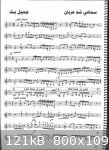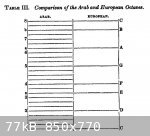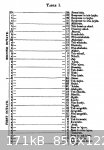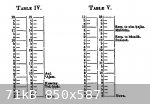| Pages:
1
2 |
myeyes2020
Oud Junkie
    
Posts: 172
Registered: 10-5-2007
Member Is Offline
Mood: na3im
|
|
this link will give the description.
http://www.maqamworld.com/maqamat/sikah.html#sikah-baladi
here are the musical forms.
http://www.maqamworld.com/forms.html
notice how it says regarding samai that the third khana of the samai modulates to related maqams.
Knowing about these forms, especially taqsim, dulab, samai and muashah might be of interest to you becuase George Abyad mixes these in his
compositions.
The majority of this composition, samai shadd araban ,is mostly (about 4 minutes) taqsim.
"taqsim" is often loosely translated as "improvisation" but the word means "the dividing" or breaking down. derived from the arabic verb "qusama" (to
divide). It's understood to mean the melodic development of a maqam with it's associated rules (doesnt include "pathway" or sayer") but is not part
of the definition of a maqam (as some people accept "sayer" to be part of the definition).
So regarding your question about F natural, wouldnt the above simply suggest that in the taqsim, George Abyad is simply modutating from upper jins
Higaz to Kurd on D? Rather than the maqam shadd araban having a complex definition that includes it not be a "scale" or duplicated at the next
"octave?"
|
|
|
David.B
Oud Junkie
    
Posts: 640
Registered: 9-5-2009
Location: France
Member Is Offline
Mood: Renaissance
|
|
[/url]
Thanks, I didn't know Sikah-Baladi and I forgot to check on "Maqam World". Really interesting...
Quote: Originally posted by myeyes2020  | here are the musical forms.
http://www.maqamworld.com/forms.html
notice how it says regarding samai that the third khana of the samai modulates to related maqams.
Knowing about these forms, especially taqsim, dulab, samai and muashah might be of interest to you becuase George Abyad mixes these in his
compositions. |
Now I remember why I didn't go further with musical forms : I was not able to make a correspondence between what I was reading on "Maqam World" and
what I was hearing on George Abyad's CD.
Quote: Originally posted by myeyes2020  | | So regarding your question about F natural, wouldnt the above simply suggest that in the taqsim, George Abyad is simply modutating from upper jins
Higaz to Kurd on D? Rather than the maqam shadd araban having a complex definition that includes it not be a "scale" or duplicated at the next
"octave?" |
I think we should split this discussion in 2 :
-1rstly, what is the general understanding of Shadd `Araban and its ambitus.
-2ndly, what is George Abyad's understanding of Shadd `Araban and its ambitus in this taksim.
This is really interesting and I need a deep reflexion before I go further. I've got to play it carefully once more, I must decorticate the Samai and
check out the outro on the rhythm Bambi Kabir (not done yet because I don't have this rhythm). At last I must read all my written sources once
more.
My first impression :
-On the1rst point, Shadd `Araban is Hijaz Kar on GG + Hijaz Kar on G (when I write nothing it means "maqam" otherwise I use "genre", "jins",
"tetrachord", etc.).
-On the 2nd point, Shadd `Araban is Hijaz Kar on GG + Hijaz on G. Because a modulation involve a maqam as origin and a maqam as modulation. The maqam
as modulation should be less supported than the maqam as origin. Here the f natural is always used except for a quick f# at 05:29 (maybe what I
understand as a compound mode Hijaz Kar on c + Hijaz Kar on g is not insignificant), as a wink to Shadd `Araban in the lower octaves. In consequence
the maqam which contains the f natural is more supported than the maqam which contains the f#. In my opinion this last one is the maqam as modulation.
Also I heard furtively the outro on Bambi Kabir and it seems the f natural is still the most supported note (though I should listen to it more
carefully).
In conclusion, I've got to go back on it for a better understanding. I can't stay on suppositions, the duplication or non-duplication is an important
feature. Also I won't be able to study every piece of music on Shadd `Araban (the best way), I stick on one musician (the easiest way). If other
musicians can bring their own studies on the subject, that would help.
PS
Some links to work with :
http://www.maqamworld.com/realaudio/clips/shadd-araban/samai_shadd_... (the original ?)
http://www.maqamworld.com/maqamat/saba.html (Nowadays non-duplication at the octave is only represented by maqam Saba...)
|
|
|
David.B
Oud Junkie
    
Posts: 640
Registered: 9-5-2009
Location: France
Member Is Offline
Mood: Renaissance
|
|
OK, I think this score contains what we're looking for, the 1rst khana uses a f natural and the 3rd khana a f#...
From : http://www.mikeouds.com/messageboard/viewthread.php?tid=3920#pid257...

|
|
|
myeyes2020
Oud Junkie
    
Posts: 172
Registered: 10-5-2007
Member Is Offline
Mood: na3im
|
|
Quote: Originally posted by David.B  |
I think we should split this discussion in 2 :
-1rstly, what is the general understanding of Shadd `Araban and its ambitus.
-2ndly, what is George Abyad's understanding of Shadd `Araban and its ambitus in this taksim.
This is really interesting and I need a deep reflexion before I go further. I've got to play it carefully once more, I must decorticate the Samai and
check out the outro on the rhythm Bambi Kabir (not done yet because I don't have this rhythm). At last I must read all my written sources once
more.
|
RE the general understanding od Shad Araban, i dont think one exists. There are atleast two schools of thought that define "maqam". You and I are at
opposite ends.
For my needs and goals of studying Egyptian Classical music, the works of great composers Abdel Wahab, Riad al Sumbati,Baligh Hamdi etc.. , the
rudimentary understanding suffices. Shadd Araban is the scale of maqam Higaz Kar transposed on GG. It's the same ascending/desceding and duplicates
at G at the next octave.
The first time for me to hear "ambitus" was on this thread....lol and is not usefull for my goals and needs. At the moment, I don't accept ambitus,
mood, or sayr as what defines a maqam. I am aware that "mood" is an attribute of a maqam. but for my puposes, it doesnt distinguish the higaz Kar-D
from higaz kar-GG (or rahat al arwah from Huzam) as two different maqamat.
From an anaylical and my perspective, since mood is subjective, it can be an atribute but not an element of a maqam.
Re the second form of maqam saba (which doesnt end on the same "note" as the tonic). I consider that maqam an exception, an abarent maqam that is
useless for my needs. It doesnt change my view the the "primary" maqamat ( al maqamat al asasiyeen) and important maqamat (al maqamat al moHemeen) as
scales that are transposable and duplicated at the "octave."
That being said, I'm aware that students of Turkish music see a maqam from a different light. Indeed the beautiful music is different and sounds
exotic even to my ears. So the definition of maqam for Turkish music most likely and correctly includes sayr,mood and ambitus.
Re George Abyad's understanding; someone better than me should comment on that. Quite frankly, I'm surprised no one else has chimed in on this
discussion except briefly by fastforward.
Consider posting your next George Abyad study before analyzing it. It may be helpful for someone (better than me) to identify the Arabic music forms
that he's using in his compositions. For example if he calls his compositon a "taqsim," the taqsim may be introduced by a dublab, muashah, samai
etc... Of course this is if you dont recognize the forms yourself.
I agree that this is quite interesting and thank you for opening my mind as I also need to study and hopefully one day appreciate the need for sayr
and really know why the well studied avoid the word "scale."
|
|
|
myeyes2020
Oud Junkie
    
Posts: 172
Registered: 10-5-2007
Member Is Offline
Mood: na3im
|
|
That's very resourcefull that you found the score.
the score doesnt include 3rd and 4th khana. the last 4 Lines are "khana 2" and the sinu means that you have to return to the taslim (refrain) 4th
lline from the top.
|
|
|
David.B
Oud Junkie
    
Posts: 640
Registered: 9-5-2009
Location: France
Member Is Offline
Mood: Renaissance
|
|
Quote: Originally posted by myeyes2020  |
Re George Abyad's understanding; someone better than me should comment on that. Quite frankly, I'm surprised no one else has chimed in on this
discussion except briefly by fastforward. |
Yes, it seems that talking about maqamat is not in fashion 
That's why I thank you especially because this not what you're studying. I mean classical vs traditional (these are my subjective words to express
music after and before 1932).
Yes, I did it for Nakriz without any constructive answers, though I asked many questions !
|
|
|
David.B
Oud Junkie
    
Posts: 640
Registered: 9-5-2009
Location: France
Member Is Offline
Mood: Renaissance
|
|
Quote: Originally posted by myeyes2020  | That's very resourcefull that you found the score.
the score doesnt include 3rd and 4th khana. the last 4 Lines are "khana 2" and the sinu means that you have to return to the taslim (refrain) 4th
lline from the top. |
Thanks for the tip, I'm not so aware about musical forms with rhythm...
|
|
|
David.B
Oud Junkie
    
Posts: 640
Registered: 9-5-2009
Location: France
Member Is Offline
Mood: Renaissance
|
|
PS
Check out your u2u Inbox, among other things "A treatise on Arabic music chiefly from a work by Mikhâil Meshâkah of Damascus" in Pdf.
|
|
|
myeyes2020
Oud Junkie
    
Posts: 172
Registered: 10-5-2007
Member Is Offline
Mood: na3im
|
|
thanks i will check the u2u, never did that before..lol
Samai Bayati by Ibrahim al eryan.
to really get the feel of samai, it would be in your best interest to check out this link, it was very helpful to me.
http://www.mikeouds.com/messageboard/viewthread.php?tid=2966#pid323...
mp3 of samai by oudman and the pdf of the score by microbar.
In the interest of time, none of the audio perfomances did the samai exact (didnt fully repeat the refrain, khana 2, 3 and 4 etc.) however gives a
fantastic idea of it's structure.
you will notice that the first khana intruduces the maqam.
The taslim (refrain) in all samai should end in a bar labeled 1 and a bar labed "2". it is played twice and the first time ends at "1' then repeats
and then ends at 2... then you go to the next khana. after the 4th khana you end with taslim.
I am working on this samai now. once you see this, I trust you will be confident in Samai.
BTW "Samai" means the listening or the hearing or the audition [of].
thanks again for the u2u
|
|
|
David.B
Oud Junkie
    
Posts: 640
Registered: 9-5-2009
Location: France
Member Is Offline
Mood: Renaissance
|
|
Quote: Originally posted by David.B  | "A treatise on Arabic music chiefly from a work by Mikhâil Meshâkah of Damascus" p. 183 and 185
Be prudent before you make easy conclusion, this is the early modern period and the notes don't correspond with nowadays theory. If I do not say
stupid things Yegâh is CC (or C), Rest GG (or G) (if somebody can refresh my memory) etc. |
Yegâh is C, `Ösheirân is D, Kuwesht is E, Rest is F, Dûgâh is G, Bûselîk is A, Hejâz is B and Nawa is c.
"Observe that the beginning of the notes of the octave with yegâh, as above, is not necessary in the nature of things. Some authors begin with rest ;
and the Greeks begin with dûgâh. One may begin where he chooses, provided he make the octave consist of seven successive notes, so that the eighth
shall be the response to the first." -> A treatise on Arabic music chiefly from a work by Mikhâil Meshâkah of Damascus p.176
Observe that the modern sight : Yegâh is GG, `Ösheirân is AA, Kuwesht is BB, Rest is C, Dûgâh is D, Bûselîk is E, Hejâz is F and Nawa is g, is
used in the following posts.


|
|
|
David.B
Oud Junkie
    
Posts: 640
Registered: 9-5-2009
Location: France
Member Is Offline
Mood: Renaissance
|
|
"§5. On variety in tunes, and their division into modes.
The difference between tunes is of four kinds. The first is in the key note. If you strike, for example, rest, then `arâk, then `ösheirân, and end
with yegâh, making it the key note, the sound differs from what it would be, if you struck dûgâh, then rest, then `arâk, and ended with
`ösheirân for the key note. And this difference does not arise from the height of dûgâh and `ösheirân, with which you begin and end the one,
above rest and yegâh the first and last notes of the other. For difference in height, were the intervals between all the notes the same, would
occasion no variety in tunes, and you might vary the key note, without varying the melody. But as it is, varying the key note varies the tune, because
the intervals are unequal, and a succession of them is passed over in the one case, differing from that passed over in the other. As in the example
above adduced in the first strain, the first two intervals are or three quarters each, and the third of four ; while in the second strain, the first
interval is of four quarters and the other two of three quarters each. Thus appears the first kind of difference between tunes. In consequence of it,
tunes are divided into modes according to their key notes, and are named from them ; one being called rest, another dûgâh, &c.
The second difference arises from two circumstances independent of the key note, which may remain unchanged. One is a difference of execution in
passing from note to note, which is not to be described in words, and which the Arabs have no notation, as the Greeks and the Franks have, to express.
The other is a difference in the notes with which different tunes begin. The two tunes dûgâh, and suba, for example, are both keyed on dûgâh, but
the first begins with rest, and the other with jehârgâh ; as we shall see when we come to the description of particular tunes.
The third difference arises from a change of some notes, by substituting certain quarters for them. For example, in the tune called hejâz, the note
jehârgâh is not used ; but in ascending and descending it is passed over, and the quarter hejâz is struck in its place. So in the tune beyâty, the
quarter `ajem is used in the place of the note auj.
The fourth difference arises from the tunes being double ; the first or second cause of difference being united with the third. In this case, the
voice passes over more than seven notes, striking notes in two octaves, which are the responses and bases to each other. For example, the tune
muhaiyar is tune dûgâh repeated ; dûgâh being first sung on an octave dûgâh, and then the voice descending to the base of that, which is the
octave to which dûgâh itself belongs. So the tune shed-`arabân, is made up of two hejâzes, on two different octaves. And `ösheirân is almost
beyâty, sung from above huseiny, and then ending in beyâty on `ösheirân.
6. On Transposition, or the performing of a tune on another than its natural scale.
Musicians are sometimes obliged to perform tunes on other than their proper key notes. For example, dûgâh and hejâz, whose proper key note is
dûgâh, are usually performed on nawa, in order, by a higher pitch, to give more pleasure to the hearer. This change is sometimes necessary. As, when
a double tune, which takes in more than one octave, is keyed on a high note. Shed-`arabân, for example, whose key note is dûgâh, requires the voice
to ascend to the response to huseiny, which is extremely difficult for most performers, and even if accomplished, produces an unpleasant effect upon
the hearer. Hence this tune is generally performed on yegâh or `ösheirân. The same key notes, also, are generally adopted for the tune muhaiyar. A
similar necessity likewise exists, when you wish to play on two instruments together, one of which, as a large kânôn for example, is made for very
low notes, and will not bear tuning for high ones, and the other, as a short kerift, is pitched very high. Then the performance on the two will not
agree, unless one or the performers transposes the tune so as to play it on such a key note as shall accord with the key note on which the other
performs. Hence the professors of the art of music, have found it necessary to be exceedingly careful in the composition of tunes, to define and
observe the exact number of quarters which compose the intervals between the different votes. For it is only in consequence of this exactness, that
the musician is able to transpose a tune by changing its key note.
For illustration of what has been said above, take two examples. First ; suppose it be desired to transpose a tune keyed on dûgâh, so as to perform
it on nawa. Then is will necessary to change two notes, huseiny and auj, by striking instead of them, the quarters tek-hisâr and `ajem, next below
them. This being done, the succession of intervals in the transposed tune, will be the same as in the original, as may be seen in Table IV., below.
Second ; suppose it be desired to transpose a tune on rest so that it can be performed on nawa. Inasmuch as nawa is a fifth above rest, the first five
notes will require no change, for reasons explained in section 4. But the next two notes do not correspond, and it bocomes necessary to raise buzereh
and mâhûrân each one quarter, by using the quarters response to bûselîk and response to nîm-hejâz, instead of them, in order to preserve the
intervals of the original tune, as may be seen in Table V." -> A treatise on Arabic music chiefly from a work by Mikhâil Meshâkah of Damascus
p.181
"§1. Melodies keyed on Yegâh.
2. Shed-`arabân. This is in fact hejâz repeated in two octaves, to render the pitch easy for the singer. Its notes are 8, 8b, 8, 11, 10a, 8b, 8, 12,
12b, 12, 11, 10a, 8b, 8, 7, 5b, 5, 4, 3a, 2,1." -> A treatise on Arabic music chiefly from a work by Mikhâil Meshâkah of Damascus p.185
My own way :
Nawa (G), Hisâr (Ab), Nawa (G), Mâhûr (c), Nihuft (B), Hisâr (Ab), Nawa (G), Muhaiyar (d), Sumbuleh (eb), Muhaiyar (d), Mâhûr (c), Nihuft (B),
Hisâr (Ab), Nawa (G), Jehârgâh (F), Kurdy (Eb), Dûgâh (D), Rest (C), Kuwesht (BB), `Ösheirân (AA), Yegâh (GG).
"§4. Melodies keyed on rest.
8. Hejâzkâr. It is 4, 8 distinctly, 8b, 8 distinctly, 7 distinctly, 6a, 4c, 4, 1, 4. Thus the Constantinople masters have arranged it. In it 5 and 6
are altered to 4c and 6a. Evidently this arrangement is that which is necessary for the performance of the tune hejâz itself ; except that the
quarter 7b must be made 7a. And if it be thus arranged, and 5 be made its keynote, it will be easier, or only one note, viz. 7, will be altered to a
quarter." -> A treatise on Arabic music chiefly from a work by Mikhâil Meshâkah of Damascus p.187
My own way :
Rest (C), Nawa (G) distinctly, Hisâr (Ab), Nawa (G) distinctly, Jehârgâh (F) distinctly, Bûselîk (E), Tek-zergelâh (D-b-), Rest (C), Yegâh
(GG), Rest (C).
So the ancient understanding of Shadd `Araban vs Hijaz Kar is very different from nowadays understanding.
Also observe the old jins Hijaz is Dûgâh (D) {3 quarters} Sigâh (E-b-) {5 quarters} Hejâz (F#) {2 quarters} Nawa (G).
In the old maqam Hijaz Kar : Rest (C) {3 quarters} Tek-zergelâh (D-b-) {5 quarters} Bûselîk (E) {2 quarters} Jehârgâh (F).
While the old Shadd `Araban (Hijaz on G) is Nawa (G) {2 quarters} Hisâr (Ab) {6 quarters} Nihuft (B) {2 quarters} Mâhûr (c).
Nowadays we assimilate maqam Shadd `Araban as a transposition of maqam Hijaz Kar, so why purists want to keep the old fashion by saying "Shadd
`Araban" instead of "Hijaz Kar on GG" ? This is an open question, my own answer is because it keeps the heritage of Arab music in its name.

|
|
|
David.B
Oud Junkie
    
Posts: 640
Registered: 9-5-2009
Location: France
Member Is Offline
Mood: Renaissance
|
|
PS
By chance you can hear the difference on this CD :
http://www.mikeouds.com/messageboard/viewthread.php?tid=7795
02. Shadd Araban 1:06
23. Hijazkar 1:50
|
|
|
| Pages:
1
2 |
|